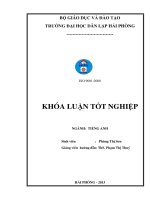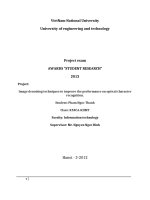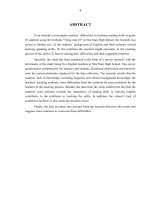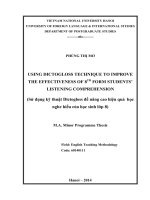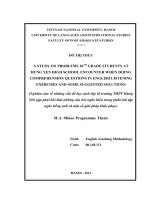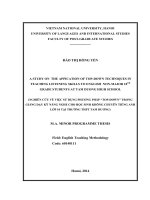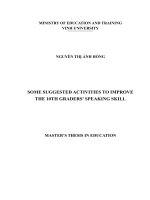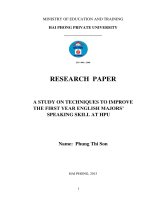Some pre listening techniques to motivate 10th students at nong cong II school to improve the listening skills’
Bạn đang xem bản rút gọn của tài liệu. Xem và tải ngay bản đầy đủ của tài liệu tại đây (124.53 KB, 15 trang )
SỞ GIÁO DỤC VÀ ĐÀO TẠO THANH HOÁ
TABLE
CONTENT
TRƯỜNG
THPT NÔNG CỐNG II Page
Part I: INTRODUCTION
1
I.
Rationale
II.
Aims of the study
III.
Research methodology
Part II: DEVELOPMENT
3
1. Factors in teaching and learning listening skills
2. The role of pre-listening techniques
3. The importance of motivation in second language learning
Part III – DATA ANALYSIS
SÁNG
KIẾN KINH NGHIỆM
4
I.
Situation analysis
1.
Tenth-form
NHỮNG
THỦ students:
THUẬT DẠY Ở GIAI ĐOẠN TIỀN NGHE
2.
The teachers of English at Nong Cong II high school
HIỂU
NHẰM
THÚC
II. Data
analysis
resultĐẨY HỌC SINH LỚP 10 THPT NÔNG
1.
Teachers and students’ attitudes towards the role of pre-listening
CỐNG 2 PHÁT TRIỂN KỸ NĂNG NGHE
techniques.
1.1. Teachers’ attitude toward the role of pre-listening techniques.
1.2. Students’ attitude toward the role of pre-listening techniques
2. Students’ preferences for pre-listening techniques.
3. The situation of using pre-listening techniques.
4.Data analysis of the class experience teaching
Part IV – SUGGESTIONS FOR EMPLOYING PRE-LISTENING TECHNIQUES 8
Người thực hiện: Nguyễn Thị Thu Hằng
1. Using pre-listening
techniques
at Nong
Chức
vụ: Giáo
viênCong II appropriately and flexibly
2. Encouraging the stuents’ internal factors
SKKN thuộc lĩnh vực: Tiếng Anh
3. Improving the pre-listening activities in the Textbook English 10
Part V: CONCLUSION
10
REFERENCES
11
APPENDICES
12
THANH HOÁ NĂM 2016
1
Part I: INTRODUCTION
1. Rationale
English is, nowadays, needed in every field of our lives and for such a
long time it has been not only a compulsory subject in schools in Vietnam
but one of three major subjects in the entrance exam to some Universities
and Colleges as well.
Of all four skills: listening, speaking , reading and writing, listening is
always considered to be most difficult for teachers to teach and for students
to improve themselves, which leads to the fact that learners are afraid to
learn listening skills.
The ablity to understand the native speakers in direct conservations, on
the radio or tape may be important for learners to further study the language
and communicate in it. This is also true to students at Nong Cong II high
school, especially to 10th grade students, who little or even never practice
listening skill at lower secondary school.
It is known that a good pre-listening stage can arouse the students’
interest in listening as well as provide them language preparation which can
be helpful clues to their listening comprehension. In order to make prelistening techniques effective, the author applied a number of pre-listening
techniques helping students improve their listening skills.
All the above mentioned reasons lead to the choice of the study about
exprerience initiative in teaching ‘Some pre-listening techniques to
motivate 10th students at Nong Cong II school to improve the listening
skills’.
2. Aims of the study
The aims of the study are:
- to investigate the teachers and students’ attitudes towards the pre-listening
techniques. And examine the students’ preference for the pre-listening
techniques
- to give some suggestions for using pre-listening techniques (based on
listening lessons of “Tieng Anh 10”) to motivate 10th grade students’
listening skills at Nong Cong 2 high school.
3. Research methodology
Questionaire are designed as a means to make the researcher’s
evaluayion more objective. The questionnaires are given to tenth-form
students and teachers of English at Nong Cong II with the hope to find out
2
their attitudes towards pre-listening techniques as well as suggestions for
these techniques.
Part II: DEVELOPMENT
1.
Factors in teaching and learning listening skill.
1.1 The listening texts
A listening text may be a short story, dialogue, a piece of news, a
reading passage, ect ... written or read by native speakers in authentic
English. Therefore, learners are supposed to understand the text as much and
correctly as possible. According to Buck, G (2001): ‘Providing suitable texts
is not a simple matter. It take times, effort and some expertise’
1.2 Teacher’s role
As many students feel afraid of listening, teachers should be a guide to
help them, to courage them. Rost, M (1994) states that ‘language teachers
need to provide various types of support to their learners to help them to
develop listening skills’.
1.3 Students’ role
Obviously, students themselves play an important role in improving
their own listening skills. They not only should take an active part in learning
but also have to take the risk of making mistakes because a mistake is an
opportunity to learn.
1.4 Task difficulty
It will be good for both teachers and students to know about the factors
which makes listening difficult, because this can help them find the way to
overcome the problems they have in teaching and learing listening. In second
language teaching and learning, most of researchers focus on three following
factors: Textual factors, the types of classroom tasks and inferences.
2. The role of pre-listening techniques
This stage is carried out before students begin listening to the listening
text. It plays an essential part in the whole process of a listening lesson. The
pre activites are aimed at preparing learners with everything necessary for
listening and understanding the listening text. Normally, pre-listening stage
often lasts from five to twelve minutes depending on each lesson.
3. The importance of motivation in second language learning
Motivation is essential to success in most field of learning. We will
almost certainly fail to make the necessary effort without motivation.
Obvious, there has been a great deal of research on the role of motivation in
second language learning. However, researchers to indicate precisely how
motivation is related to learning, especially for most Vietnamese learners,
3
who are often driven by social and institutional factors such as finding better
job opportunities as well as pressure on exams
Part III – DATA ANALYSIS
I. Situation analysis
This experience report is carried out with the participation of over 120
tenth-form students in 10A1, 10A3 and 10A6 and 5 teachers of English at
Nong Cong II high school.
1. Tenth-form students:
Tenth-form students at Nong Cong II high school, aged 16, all have
learned at least 4 years (from grade 6 to grade 9). However, it can be assured
that their knowlegde of English is not the same. Most of them come from
Northern communes of Nong Cong district.
2. The teachers of English at Nong Cong II high school
Of all teachers of English of Nong Cong II high school, Five teachers
taking part in this study have been teaching ‘Tieng Anh 10’ textbook for over
8 years. Without doubt, they are experienced and enthusiastic teachers.
Morever, they are willing to help their students overcome the difficulties in
learning English.
II. Data analysis result
1. Teachers and students’ attitudes towards the role of pre-listening
techniques.
1.1. Teachers’ attitude toward the role of pre-listening techniques.
All the teachers at Nong Cong 2 high school are aware of the
importance of pre-listening techniques. While 60% of the teachers admits
they always use pre-listening techniques , and these techniques are often
used by the rest of the teachers. And the author herself recognizes their
purposes in using pre-listening techniques , which to help students to predict
the content of the text, provide background knowledge about the topic of the
text, teach new or difficult vocabulary in the text, increasing the students’
motivation in listening to the text and get them involved in the text.
1.2. Students’ attitude toward the role of pre-listening techniques
The pre-listening techniques are beneficial to students in any way, so it
is not suprising to find out majority of the students think these techniques
play an importance part in motivating them to listen because they will feel
more confident when they are guided by teachers before listening.
2. Students’ preferences for pre-listening techniques.
4
A large number of the students enjoy such techniques as using games, preteaching new words and using pre-listening questions, which the teacher
often uses. This will make teachers’ activities more effective.
3. The situation of using pre-listening techniques.
In each listening lesson, I have managed to one of these techniques before
listening to motivate the students:
* Using games to introduce the topic of the text
* Using visual aids to introduce the topic of the text
* Giving a brief introduction of the text
* Explaining the introduction of the text
* Pre – teaching new vocabulary in the listening text
* Making students brainstorm words, structures or ideas related to the
topic of the text
* Using pre-listening questions
* Using group discussion about the topic of the text
* Giving listening tasks to students
4. Data analysis of the class experience teaching
The reseacher taught three classes (10A1, 10A3 and 10A6) with
different pre-listening techniques when lead in at the pre-listening stage.
The first experience took place in class 10A1 with unit 4. The listening text
is about Vang Trang Khuyet Club, an art club, organized for mentally
retarded children. This listening text is quite long and includes lots of new
words. The teacher employed the techniques for teaching vocabulary. First,
she asked students to work in groups to guess the words deriving from the
roots: sorry, photo… In fact, some of these words will appear in the text.
Then she used pre-listening questions ‘Do you know how to take photo?’,
‘Would you like to join a photographic club?’ to introduce the topic. Last,
she pre-taught new words by giving definition or explanation. These
activities lasted in 15 minutes. The reseacher’s experience, the students were
willing to take part in teacher’s activities and eager to listen to the text.
The second experience was taken from class 10A3 with unit 5. In the text,
an old man is talking about his learning how to use a computer. The text also
includes new words which belong to informatics. The teacher prepared the
pre-listening activities very carefully and spent 15 minutes employing them.
She used the pictures of the items (radio, cell phone, computer, …) and
asked students to discuss the uses of these items. This is the good way for
students to revise the words they learnet in the reading and speaking lessons.
5
Then she introduced the topic briefly. Before asking the students to listen,
she elicited new words. Most of the students took an active part in these
activities.
For unit 8, the author of the study taught class 10A6. The listening text is
about the changes of Poffero, a small town on the south coast of England.
First, the teacher hang up two pictures of the same town at two different
point of time (in the past/ now), then asked students to discuss the
differences between them. Clearly, this attracted energetic students more than
shy ones. From the discussion, students were asked to predict the topic of the
listening text. Many students pu up their hands, which means that they could
guess the topic of the coming text. Last, the teacher pre-taught new words.
The students listened attentively and took notes carefully.
All in all, the teaching experiences help the reseacher confirm the fact that
pre-listening techniques applied by the teacher have great impact to students’
motivation before they start listening. And this is the result compared by the
previous years 2014 -2015
Listening Skills
Class
Rank
Before using prelistening
techniques(2014-2015)
After
(2015-2016)
Class
Excellent
6.81%
23.68%
10A1
Good
40.90%
62.27%
(43
students
Medium
50%
4.05%
2.27%
0%
0%
0%
Weak
Bad
Class
Excellent
2.27%
4.54%
10A3
Good
34.1%
69,99%
(50 sts)
Medium
56.81%
25.45%
Weak
4.54%
0%
Bad
0%
0%
Class
Excellent
3%
6%
10A6
Good
25%
30%
(44 sts)
Medium
57%
62%
Weak
15%
2%
6
Bad
0%
0%
Part IV – SUGGESTIONS FOR EMPLOYING PRE-LISTENING
TECHNIQUES
1. Using pre-listening techniques at Nong Cong II appropriately and
flexibly
It is obvious that motivating students to get actively involve in
listening lessons depends on several factors. However, in the experience
study, the author’s invention is to investigate into the impact of teachers’
techniques on the students’ motivation at the very first stage of the lesson:
pre-listening stage.
The techniques used at this stage are:
* Using games to introduce the topic of the text
* Using visual aids to introduce the topic of the text
* Giving a brief introduction of the text
* Explaining the introduction of the text
* Pre – teaching new vocabulary in the listening text
* Making students brainstorm words, structures or ideas related to the
topic of the text
* Using pre-listening questions
* Using group discussion about the topic of the text
* Giving listening tasks to students
Teachers should also take the flexbility of applying pre-listening
techniques into account. This work is affected by the students’ level of
proficiency and their familiarity to the topic.
Let us take the listening in Unit 4 as an example. If at the beginning of
the lesson, teacher asks “What do you know about Vang Trang Khuyet club
and its activities?” students will feel confused because many of them may
know nothing about this club. Thus, it is advisable for the teacher to make
sure that students are clear about the topic and to ask more specific
questions.
2. Encouraging the students’ internal factors
Besides the teachers’ techniques or the ways they carry on the
activities, the students’ personal things: Their feelings, their needs, their
interests or their innate characteristics have a great impact on the success of
the lesson. Thus, it is essential to assist the students to build up their strong
7
motivation for listening by raising their awareness of the importance of
motivation to their understanding as well as to their skill development.
Moreover, students should be encouraged to build up confidence in learning.
Last but not least, teacchers’ techniques or activities should meet the
demands of the students. To help students sustain long-term motivation,
teachers should consider the students’ needs and interests while designing
and and employing any kind of techniques.
3. Improving the pre-listening activities in the Textbook English 10
A large number of teachers and students are in favor of pre – listening
available in each lesson of English book 10. However, 16% of the students
suppose that these activities are boring or can not motivate them. Therefore,
it may be a good idea to add more activities that are of students’ interests,
such as games or visual aids at the pre-listening stage.
8
PART V: CONCLUSION
As teachers of English at a rural school, we have faced many obstacles
in developing students’ listening skill, and the desire of how to improve the
effectiveness of listening lessons is really the strong motivation. This study
was conducted with the hope to find out the role of pre-listening techniques
to students’ motivation in listening at Nong Cong II high school. In fact,
teachers often find it hard to get students actively involved in their listening
activities, meanwhile, the students are not always highly motivated by the
techniques their teachers apply in the lesson.
To better the listening lesson, the teachers should take such things as
teaching ang learning conditions, the listening texts, listening strategies and
students’ preference into account. In more details, some suggestions (Using
pre-listening techniques appropriately and flexibly; Encouraging the
students’ interal factors; Improving the pre-listening activities in the
material) are provided above, which, hopefully, are useful for the teachers of
English at Nong Cong II high school.
Due to the limitation of time, experience and resources, short-comings
and mistakes are inevitable. Therefore, all comments and corrections are
hightly appreciated.
Thanh Hoa March 20th, 2015
Confirmation of the Head Master of
Nong Cong II High School
I
declare
that
the
work
contained in this initiative is result of
my own research.
Nguyễn Thị Thu Hang (M.A)
9
REFERENCES
1. Anderson A& Lynch T, (1988). Listening, Oxford, Oxford University
Press
2. Field J. (1998). Skills and Strategies; towards a new methodology for
listening. Oxford University Press
3. Linggzhu, J. (2003). Listening activities for Effective to-down processing.
The Internet Journal, Vol IX, November, http: iteslj.org/
4. Hoa, H.X., et al (2004). Tài Liệu Bồi Dưỡng Giáo Viên Dạy Sách Khoa
Lớp 10 – Môn Tiếng Anh. The Ministry of Education and Training.
5. Rost, M. (1990). Listening in language learning, London, Longman
6. Ellis, M. (1986: 47). Making and shaping games. How to adapt.
University of Technology, Loughborough.
7. Ur P, J.D. (1989). Teaching Listening Comprehension. Cambrigde
University Press
8.
Van, H.V., et al (2006). Tiếng Anh 10. Education Publishing House of
Vietnam.
9. Websites:
- />-
- Englishpost.org/2013/03/16/pre-listening-activities/
- http:iteslj.org/techniques/Lingzhu-listening.html
APPENDICES
I. Appendix 1: OBSERVATIONAL PROTOCOL
1. Observational Protocol 1: Unit 4 – Van Trang Khuyet club
Class: 10A1 (Period 3from 9.20 to 10.05)
Date: Monday, 23/10/2015
Teacher’s activities
Students’attitu
des toward T’s
activities
Students’
involvement
-At 9.20 a.m,
teacher comes in
10
Students’interacti
on with each
other
and greets the
students.
- Teacher warms
up by asking
students to work in
groups of 4 or 5 to
find the different
words that derive
from the following
roots: sorry,
second…
-Students
show their
interests in the
activity. In
groups, they
discuss and
find words
-All students
get actively
involved in
groups
-Exchange the
ideas willingly
- Teacher calls
some presentatives
of the groups to
perform.
- Teacher asks
studnts questions:
“Do you know to
take photo?”;
“Would you like to
join a photographic
club?”
-They are
willing to
answer the
questions
-All students
have the same
opportunities to
answer the
questions
- Teacher
introduces new
words by giving
definition and
explanation
-Listening
attentively to
those who answer
teacher’s
questions
Summary: Teacher employed lots of pre-listening techniques, e.g making
students brainstorm words related to the topic of the text; using pre-listening
questions and teaching new words, which aroused students’ interests in
learning. These activities take place in 15 minutes.
2. Observational Protocol 2: Unit 5 – Learning how to use a computer
Class: 10A3 (Period 3 from 8.30 to 9.15)
Date: Wednesday, 8/11/2015
Teacher’s activities
Students’attitud
es toward T’s
activities
-At 8.30 a.m,
teacher comes in
11
Students’
involvement
Students’interac
tion with each
other
and greets the
students.
- Teacher ticks
some pictures of
the items (radio,
cell phone…) on
board and asks
students: “How
often do you use
this items?
- Then teacher asks
students to work in
pairs to discuss the
uses of these items
- Teacher
introduces briefly
the topic.
- Teacher elicits
new words by
giving definitions
and delivers
handouts to the
students to works
in groups
(15 minutes)
-Students are
eager to answer
teacher’s
questions
individually
-All students
have the same
opportunity to
answer
teacher’s
question
-They are
willing to work
with their
partners
-They are
interested in
taking part in
this activity
-They listen to
attentively to
the teacher
-Listen to others
attentively
-Listening
attentively to
others and
express their
ideas
-They take an
active part in
groups to fill in
the gaps with
the words they
have learnt
-All students
have the same
opportunities
to answer the
questio
Summary: Teacher used some pre-listening techniques, which attracteds’
attention and made them more interested in listening to the text. The pelistening activities emploed in this lesson were: using visual aids to introduce
the words related the topic; using brief introdution of the text and teaching
new words by giving explanation
3. Observational Protocol 3: Unit 8 – The changes of a small town
Class: 10A6 (Period 4 from 10.15 to 11.00)
Date: Saturday, 2/12/2015
12
Teacher’s
activities
Students’attitu
des toward T’s
activities
Students’
involvement
Students’interact
ion with each
other
-All students
take an active
part in this
activity
-Listen to others
attentively,
correct mistakes
and give their
own ideas
-At 10.15 a.m,
teacher comes in
and greets the
students.
- Teacher ticks two
pictures of the
same town (in the
past/ now) on
board
- Teacher asks
students to work in
groups to discuss
the differences
between them
-They are
willing to work
in groups
- Teacher calls
some groups of
perform
- Teacher asks
students to predict
the topic of the text
- Teacher elicits
new words by
giving definitions,
their symnonyms
and antonyms
-They are eager
to give their
predictation
-Listen attentively
to others
(15 minutes)
Summary: In the lesson, teacher aroused students’ interests in listening by
using some techniques at the pre-listening stage, such as using visual aids to
introduce the topic, teaching new words by giving definition, their synonyms
and antonyms.
II. Appendix 2: TOPICS OF THE LISTENING TEXTS IN ENGLISH
BOOK 10
Unit 1: Monologue about a cyclo driver
Unit 2: Some small talks at school
13
Unit 3: An interview with the olympic Champion
Unit 4:Monologue about Vang Trang Khuyet Club
Unit 5: Monologue – An old man talks about his learning how to use a
computer
Unit 6: Monologue – Weekend picnics
Unit 7: Radio news
Unit 8: The changes of a village
Unit 9: Monologue about whales
Unit 10:Destroying forests
Unit 11: Cuc Phuong National Park
Unit 12: Van Cao – a great musician
Unit 13: Arrangement to see a film
Unit 14: Pele – an internationally famous footballer
Unit 16: The ancient town of Hoi An
14
TABLE CONTENT
Page
Part I: INTRODUCTION
IV.
Rationale
V.
Aims of the study
VI.
Research methodology
1
Part II: DEVELOPMENT
3
1. Factors in teaching and learning listening skills
2. The role of pre-listening techniques
3. The importance of motivation in second language learning
Part III – DATA ANALYSIS
4
III. Situation analysis
3.
Tenth-form students:
4.
The teachers of English at Nong Cong II high school
IV. Data analysis result
2.
Teachers and students’ attitudes towards the role of pre-listening
techniques.
2.1. Teachers’ attitude toward the role of pre-listening techniques.
2.2. Students’ attitude toward the role of pre-listening techniques
2. Students’ preferences for pre-listening techniques.
3. The situation of using pre-listening techniques.
4.Data analysis of the class experience teaching
Part IV – SUGGESTIONS FOR EMPLOYING PRE-LISTENING TECHNIQUES 8
4. Using pre-listening techniques at Nong Cong II appropriately and flexibly
5. Encouraging the stuents’ internal factors
6. Improving the pre-listening activities in the Textbook English 10
Part V: CONCLUSION
10
REFERENCES
11
APPENDICES
12
15
